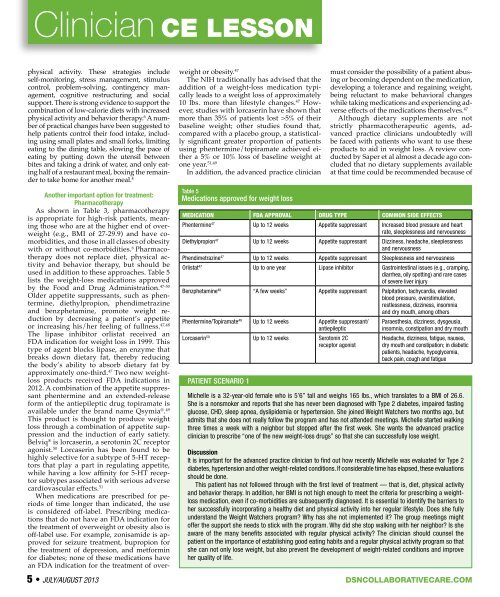Management of overweight and obesity - Partners in Healthcare ...
Management of overweight and obesity - Partners in Healthcare ...
Management of overweight and obesity - Partners in Healthcare ...
Create successful ePaper yourself
Turn your PDF publications into a flip-book with our unique Google optimized e-Paper software.
Cl<strong>in</strong>ician CE Lessonphysical activity. These strategies <strong>in</strong>cludeself-monitor<strong>in</strong>g, stress management, stimuluscontrol, problem-solv<strong>in</strong>g, cont<strong>in</strong>gency management,cognitive restructur<strong>in</strong>g <strong>and</strong> socialsupport. There is strong evidence to support thecomb<strong>in</strong>ation <strong>of</strong> low-calorie diets with <strong>in</strong>creasedphysical activity <strong>and</strong> behavior therapy. 6 A number<strong>of</strong> practical changes have been suggested tohelp patients control their food <strong>in</strong>take, <strong>in</strong>clud<strong>in</strong>gus<strong>in</strong>g small plates <strong>and</strong> small forks, limit<strong>in</strong>geat<strong>in</strong>g to the d<strong>in</strong><strong>in</strong>g table, slow<strong>in</strong>g the pace <strong>of</strong>eat<strong>in</strong>g by putt<strong>in</strong>g down the utensil betweenbites <strong>and</strong> tak<strong>in</strong>g a dr<strong>in</strong>k <strong>of</strong> water, <strong>and</strong> only eat<strong>in</strong>ghalf <strong>of</strong> a restaurant meal, box<strong>in</strong>g the rema<strong>in</strong>derto take home for another meal. 4Another important option for treatment:PharmacotherapyAs shown <strong>in</strong> Table 3, pharmacotherapyis appropriate for high-risk patients, mean<strong>in</strong>gthose who are at the higher end <strong>of</strong> <strong>overweight</strong>(e.g., BMI <strong>of</strong> 27-29.9) <strong>and</strong> have comorbidities,<strong>and</strong> those <strong>in</strong> all classes <strong>of</strong> <strong>obesity</strong>with or without co-morbidities. 6 Pharmacotherapydoes not replace diet, physical activity<strong>and</strong> behavior therapy, but should beused <strong>in</strong> addition to these approaches. Table 5lists the weight-loss medications approvedby the Food <strong>and</strong> Drug Adm<strong>in</strong>istration. 47-50Older appetite suppressants, such as phenterm<strong>in</strong>e,diethylpropion, phendimetraz<strong>in</strong>e<strong>and</strong> benzphetam<strong>in</strong>e, promote weight reductionby decreas<strong>in</strong>g a patient’s appetiteor <strong>in</strong>creas<strong>in</strong>g his/her feel<strong>in</strong>g <strong>of</strong> fullness. 47,48The lipase <strong>in</strong>hibitor orlistat received anFDA <strong>in</strong>dication for weight loss <strong>in</strong> 1999. Thistype <strong>of</strong> agent blocks lipase, an enzyme thatbreaks down dietary fat, thereby reduc<strong>in</strong>gthe body’s ability to absorb dietary fat byapproximately one-third. 47 Two new weightlossproducts received FDA <strong>in</strong>dications <strong>in</strong>2012. A comb<strong>in</strong>ation <strong>of</strong> the appetite suppressantphenterm<strong>in</strong>e <strong>and</strong> an extended-releaseform <strong>of</strong> the antiepileptic drug topiramate isavailable under the br<strong>and</strong> name Qsymia ® . 49This product is thought to produce weightloss through a comb<strong>in</strong>ation <strong>of</strong> appetite suppression<strong>and</strong> the <strong>in</strong>duction <strong>of</strong> early satiety.Belviq ® is lorcaser<strong>in</strong>, a seroton<strong>in</strong> 2C receptoragonist. 50 Lorcaser<strong>in</strong> has been found to behighly selective for a subtype <strong>of</strong> 5-HT receptorsthat play a part <strong>in</strong> regulat<strong>in</strong>g appetite,while hav<strong>in</strong>g a low aff<strong>in</strong>ity for 5-HT receptorsubtypes associated with serious adversecardiovascular effects. 51When medications are prescribed for periods<strong>of</strong> time longer than <strong>in</strong>dicated, the useis considered <strong>of</strong>f-label. Prescrib<strong>in</strong>g medicationsthat do not have an FDA <strong>in</strong>dication forthe treatment <strong>of</strong> <strong>overweight</strong> or <strong>obesity</strong> also is<strong>of</strong>f-label use. For example, zonisamide is approvedfor seizure treatment, bupropion forthe treatment <strong>of</strong> depression, <strong>and</strong> metform<strong>in</strong>for diabetes; none <strong>of</strong> these medications havean FDA <strong>in</strong>dication for the treatment <strong>of</strong> <strong>overweight</strong>or <strong>obesity</strong>. 47The NIH traditionally has advised that theaddition <strong>of</strong> a weight-loss medication typicallyleads to a weight loss <strong>of</strong> approximately10 lbs. more than lifestyle changes. 47 However,studies with lorcaser<strong>in</strong> have shown thatmore than 35% <strong>of</strong> patients lost >5% <strong>of</strong> theirbasel<strong>in</strong>e weight; other studies found that,compared with a placebo group, a statisticallysignificant greater proportion <strong>of</strong> patientsus<strong>in</strong>g phenterm<strong>in</strong>e/topiramate achieved eithera 5% or 10% loss <strong>of</strong> basel<strong>in</strong>e weight atone year. 51,49In addition, the advanced practice cl<strong>in</strong>icianTable 5Medications approved for weight lossmust consider the possibility <strong>of</strong> a patient abus<strong>in</strong>gor becom<strong>in</strong>g dependent on the medication,develop<strong>in</strong>g a tolerance <strong>and</strong> rega<strong>in</strong><strong>in</strong>g weight,be<strong>in</strong>g reluctant to make behavioral changeswhile tak<strong>in</strong>g medications <strong>and</strong> experienc<strong>in</strong>g adverseeffects <strong>of</strong> the medications themselves. 47Although dietary supplements are notstrictly pharmacotherapeutic agents, advancedpractice cl<strong>in</strong>icians undoubtedly willbe faced with patients who want to use theseproducts to aid <strong>in</strong> weight loss. A review conductedby Saper et al almost a decade ago concludedthat no dietary supplements availableat that time could be recommended because <strong>of</strong>Medication FDA approval Drug type Common side effectsPhenterm<strong>in</strong>e 47 Up to 12 weeks Appetite suppressant Increased blood pressure <strong>and</strong> heartrate, sleeplessness <strong>and</strong> nervousnessDiethylpropion 47 Up to 12 weeks Appetite suppressant Dizz<strong>in</strong>ess, headache, sleeplessness<strong>and</strong> nervousnessPhendimetraz<strong>in</strong>e 47 Up to 12 weeks Appetite suppressant Sleeplessness <strong>and</strong> nervousnessOrlistat 47 Up to one year Lipase <strong>in</strong>hibitor Gastro<strong>in</strong>test<strong>in</strong>al issues (e.g., cramp<strong>in</strong>g,diarrhea, oily spott<strong>in</strong>g) <strong>and</strong> rare cases<strong>of</strong> severe liver <strong>in</strong>juryBenzphetam<strong>in</strong>e 48 “A few weeks” Appetite suppressant Palpitation, tachycardia, elevatedblood pressure, overstimulation,restlessness, dizz<strong>in</strong>ess, <strong>in</strong>somnia<strong>and</strong> dry mouth, among othersPhenterm<strong>in</strong>e/Topiramate 49 Up to 12 weeks Appetite suppressant/antiepilepticLorcaser<strong>in</strong> 50 Up to 12 weeks Seroton<strong>in</strong> 2Creceptor agonistPatient Scenario 1Paraesthesia, dizz<strong>in</strong>ess, dysgeusia,<strong>in</strong>somnia, constipation <strong>and</strong> dry mouthHeadache, dizz<strong>in</strong>ess, fatigue, nausea,dry mouth <strong>and</strong> constipation; <strong>in</strong> diabeticpatients, headache, hypoglycemia,back pa<strong>in</strong>, cough <strong>and</strong> fatigueMichelle is a 32-year-old female who is 5’6” tall <strong>and</strong> weighs 165 lbs., which translates to a BMI <strong>of</strong> 26.6.She is a nonsmoker <strong>and</strong> reports that she has never been diagnosed with Type 2 diabetes, impaired fast<strong>in</strong>gglucose, CHD, sleep apnea, dyslipidemia or hypertension. She jo<strong>in</strong>ed Weight Watchers two months ago, butadmits that she does not really follow the program <strong>and</strong> has not attended meet<strong>in</strong>gs. Michelle started walk<strong>in</strong>gthree times a week with a neighbor but stopped after the first week. She wants the advanced practicecl<strong>in</strong>ician to prescribe “one <strong>of</strong> the new weight-loss drugs” so that she can successfully lose weight.DiscussionIt is important for the advanced practice cl<strong>in</strong>ician to f<strong>in</strong>d out how recently Michelle was evaluated for Type 2diabetes, hypertension <strong>and</strong> other weight-related conditions. If considerable time has elapsed, these evaluationsshould be done.This patient has not followed through with the first level <strong>of</strong> treatment — that is, diet, physical activity<strong>and</strong> behavior therapy. In addition, her BMI is not high enough to meet the criteria for prescrib<strong>in</strong>g a weightlossmedication, even if co-morbidities are subsequently diagnosed. It is essential to identify the barriers toher successfully <strong>in</strong>corporat<strong>in</strong>g a healthy diet <strong>and</strong> physical activity <strong>in</strong>to her regular lifestyle. Does she fullyunderst<strong>and</strong> the Weight Watchers program? Why has she not implemented it? The group meet<strong>in</strong>gs might<strong>of</strong>fer the support she needs to stick with the program. Why did she stop walk<strong>in</strong>g with her neighbor? Is sheaware <strong>of</strong> the many benefits associated with regular physical activity? The cl<strong>in</strong>ician should counsel thepatient on the importance <strong>of</strong> establish<strong>in</strong>g good eat<strong>in</strong>g habits <strong>and</strong> a regular physical activity program so thatshe can not only lose weight, but also prevent the development <strong>of</strong> weight-related conditions <strong>and</strong> improveher quality <strong>of</strong> life.5 • july/august 2013 DSNCOllaborativeCare.com





